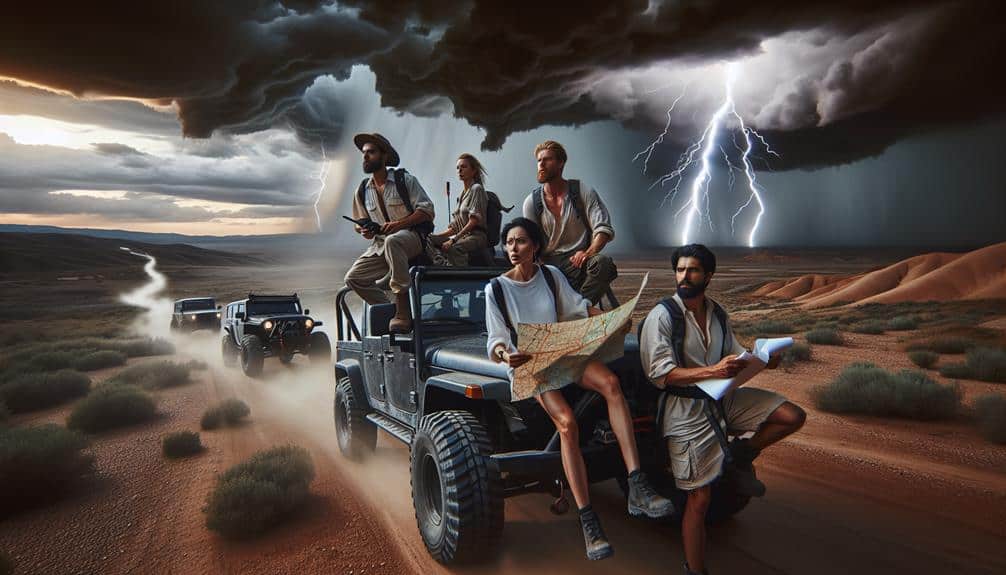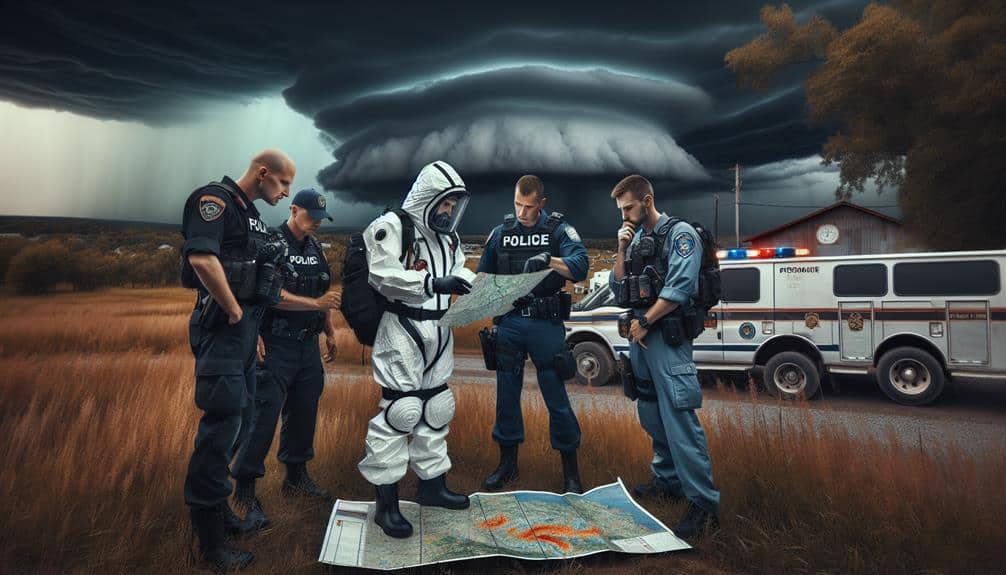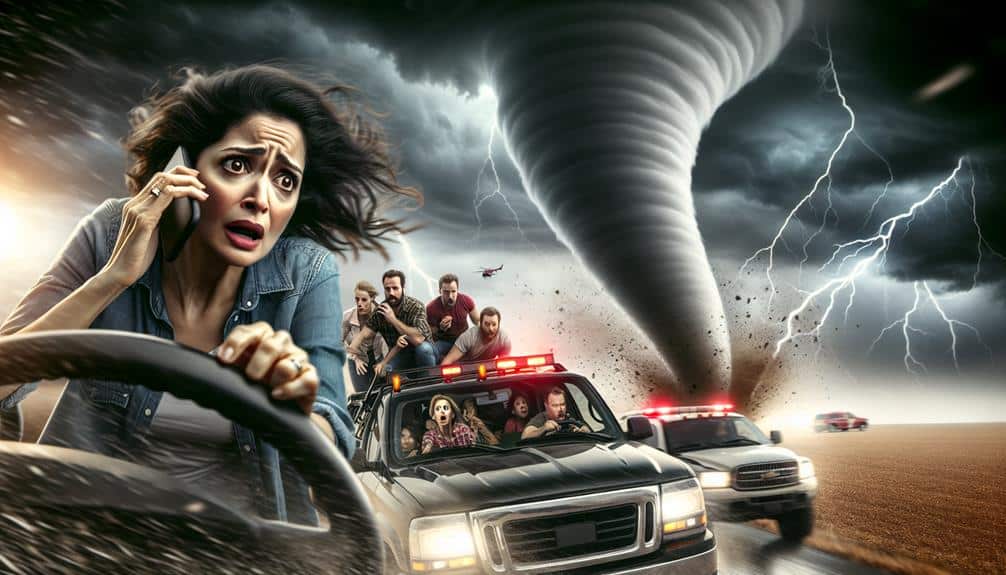Coordination is vital for us rural storm chasers because it ensures accurate data collection, strong safety protocols, and optimized emergency responses. Leveraging real-time weather updates, radar data, and integrated meteorological tools helps us make data-driven decisions. Efficiently sharing resources enhances our operational effectiveness and community support. In navigating remote areas, robust communication and topographic data allow precise positioning and real-time risk assessments. Collaboration with local authorities further refines our predictive models and public safety efforts. By streamlining these elements, we enhance response times and overall mission efficacy, exploring how these strategies improve our storm-chasing operations.
Key Points
- Ensures accurate data collection and adherence to safety protocols.
- Enhances emergency response effectiveness and team dynamics.
- Facilitates swift relay of critical information through robust communication channels.
- Optimizes resource allocation and maximizes equipment and personnel utilization.
Importance of Team Communication
Effective team communication is essential for rural storm chasers to ensure accurate data collection and enhance safety protocols. When we operate in remote areas, our team dynamics can greatly impact the effectiveness of our emergency response. We rely on robust communication strategies to relay critical information swiftly and precisely, ensuring each member is aware of the evolving weather conditions and potential hazards.
In the unpredictable environment of storm chasing, the ability to coordinate well is paramount. Real-time updates about storm trajectories, wind speeds, and barometric pressures must be shared instantly among team members. This seamless communication enables us to make informed decisions, deploy equipment effectively, and navigate the terrain safely.
Moreover, in remote areas where conventional communication networks may be unreliable, we use specialized communication devices and protocols. Satellite radios, GPS trackers, and encrypted messaging systems are integral to our operations. These tools help us maintain connectivity, bolstering our collective situational awareness and facilitating rapid emergency response when necessary.
Real-Time Weather Updates
To maintain our situational awareness, we rely on real-time weather updates that provide us with the latest data on storm developments. These updates are pivotal for our emergency response efforts and accurate weather tracking. By integrating advanced meteorological tools, we can make informed decisions and navigate safely through volatile weather conditions.
Here are key components we use for real-time weather updates:
- Radar Data: High-resolution radar imagery allows us to monitor precipitation intensity, storm cell structures, and potential tornado formations. This data is essential for predicting storm paths and evaluating immediate threats.
- Satellite Imagery: Geostationary and polar-orbiting satellites deliver detailed visual and infrared images that help us track cloud movements, storm evolution, and atmospheric conditions on a macro scale.
- Weather Stations: Ground-based weather stations provide localized data on temperature, humidity, wind speed, and barometric pressure. These metrics are crucial for understanding microclimates and making precise predictions.
- Mobile Apps and Platforms: Real-time updates via mobile applications and specialized platforms guarantee we receive instant alerts and detailed forecasts. These tools enhance our mobility and readiness for rapid response.
Sharing Critical Resources
Sharing essential resources among storm chasers guarantees we maximize our collective expertise and enhance overall safety during severe weather events. By pooling our equipment and data, we can better analyze storm patterns, predict their trajectories, and issue timely warnings. Resource sharing isn't just a matter of convenience; it's a strategic move that underpins effective emergency response and disaster management. For instance, sharing Doppler radar data or GPS coordinates ensures that we all operate with the most accurate information available, thereby reducing the risk of misinformation and enhancing decision-making capabilities.
Community support plays a pivotal role in this resource-sharing ecosystem. When we collaborate, we build a network that's resilient and responsive to the dynamic challenges posed by severe weather. This community-driven approach fosters a sense of camaraderie and mutual aid, which is vital when immediate actions are required. Data shows that coordinated teams are more effective—they can cover larger areas, verify storm data in real-time, and assist local authorities more efficiently.
Ultimately, our ability to share resources and support each other directly impacts our operational effectiveness and our capacity to save lives. In the unpredictable domain of storm chasing, this collaboration isn't just beneficial—it's essential.
Efficient Response Planning
We need to prioritize efficient response planning by integrating real-time communication channels and optimizing resource allocation.
By analyzing data on storm patterns, we can allocate our resources more effectively, ensuring critical areas receive timely assistance.
Adhering strictly to safety protocols will further enhance our operational efficiency and reduce risk.
Real-time Communication Channels
Effective response planning hinges on leveraging real-time communication channels to guarantee that storm chasers in rural areas receive timely and accurate information. By integrating advanced technology, we can greatly enhance our emergency response capabilities. Data-driven methods are essential in ensuring that we communicate effectively during critical weather events.
Real-time communication channels provide us with an array of benefits:
- Instant Data Sharing: With the integration of cutting-edge technology, we can instantly share meteorological data and storm developments, ensuring every chaser has the most up-to-date information.
- Enhanced Coordination: Real-time communication facilitates synchronized movements and decision-making, reducing the risk of miscommunication during high-stakes scenarios.
- Rapid Emergency Alerts: Immediate dissemination of emergency alerts allows storm chasers to react promptly to sudden changes in weather patterns, thereby improving safety and response times.
- Dynamic Route Adjustments: Continuous real-time updates enable us to adjust routes dynamically, optimizing our positioning relative to the storm's trajectory.
Resource Allocation Efficiency
Optimizing the allocation of resources secures that our storm chasers are strategically positioned and equipped to handle the dynamic challenges posed by severe weather events. By leveraging real-time data analytics, we can predict storm paths with higher accuracy, guaranteeing that our team coordination is both proactive and adaptive. This strategic positioning minimizes response times and maximizes response efficiency, providing a robust framework for managing the unpredictable nature of rural storm chasing.
Our approach employs advanced GIS mapping systems and meteorological models to allocate resources effectively. These tools enable us to pre-position essential equipment and personnel in high-risk areas, enhancing our overall operational readiness. Moreover, through continuous data monitoring, we can dynamically reallocate resources as storm conditions evolve, securing that no critical area is left unmonitored.
Efficient response planning is a cornerstone of our strategy. We conduct rigorous planning sessions to simulate various storm scenarios, which helps us identify potential bottlenecks and optimize resource distribution. This level of preparedness ensures that our team can react swiftly and efficiently, minimizing risks and maximizing the safety of both our storm chasers and the communities we serve.
Safety Protocols Adherence
Adhering to stringent safety protocols is essential for guaranteeing that our storm chasers can respond efficiently and minimize risk during severe weather events. Effective team coordination and adherence to emergency response guidelines allow us to maximize our operational efficiency and safety.
By closely following established safety protocols, we can enhance our preparedness and operational capabilities. This adherence not only safeguards our team but also guarantees that we can provide timely and accurate data to meteorological agencies.
Here are four critical safety protocols we consistently follow:
- Real-Time Communication: Continuous updates via satellite phones and radios to maintain constant contact, guaranteeing all team members are aware of each other's positions and status.
- Pre-Deployment Briefings: Detailed strategy sessions that outline expected weather patterns, potential hazards, and contingency plans to ensure everyone understands their role and responsibilities.
- Safety Gear Compliance: Mandatory use of personal protective equipment (PPE) such as helmets, high-visibility vests, and emergency kits to mitigate the risks associated with severe weather conditions.
- Evacuation Protocols: Pre-determined evacuation routes and procedures to guarantee a swift and orderly retreat when necessary, minimizing exposure to danger.
Through meticulous planning and strict adherence to these protocols, we can achieve a high level of safety and efficiency in our storm-chasing endeavors.

Exploring remote areas demands precise coordination of topographical data, GPS technology, and real-time weather updates to guarantee accurate positioning and safety for storm chasers. We must tackle direction challenges head-on, which often involve dealing with unmarked roads and challenging terrain. Utilizing remote communication tools, we secure teamwork efficiency, allowing us to relay critical information swiftly.
In these isolated environments, GPS technology becomes our lifeline. Without it, finding the way through the intricate network of rural roads would be nearly impossible. We integrate topographical data to identify potential obstacles and safe routes, ensuring that our team remains on course. Real-time weather updates are essential to monitor storm movements and make informed decisions.
Team coordination is essential when we face unexpected obstacles such as road closures or rapidly changing weather conditions. Effective remote communication ensures that every member is aware of their role and current position. This level of synchronization helps us adapt quickly and maintain our pursuit's momentum.
Safety Protocols and Procedures
Given the intrinsic risks of traveling through remote areas, we enforce strict safety protocols and procedures to reduce hazards and guarantee team well-being. Our approach is data-driven, employing scientific terminology and analytical language to secure precision and clarity.
First, we conduct thorough risk assessments before undertaking any storm chasing expedition. This includes evaluating weather models, terrain features, and potential road conditions. By systematically analyzing these variables, we can anticipate and mitigate risks effectively.
Second, we establish strong emergency response plans. These plans delineate specific actions to take in various scenarios, such as vehicle breakdowns, medical emergencies, or sudden changes in weather patterns. Having a predefined strategy enhances our capacity to respond swiftly and effectively.
Third, we maintain constant communication among team members and with our base operations. Utilizing advanced communication technology ensures that we can relay real-time data and updates, facilitating timely decision-making and coordination.
Fourth, we equip our vehicles with essential safety gear and supplies. This includes first aid kits, emergency food and water, and navigation tools. Adequate preparation ensures that we can sustain ourselves if isolated.
Collaboration With Local Authorities

We must prioritize collaboration with local authorities to enhance the effectiveness of our storm-chasing efforts.
By sharing real-time data, we can guarantee public safety and optimize resource allocation.
This coordination allows us to provide timely warnings and deploy emergency services more efficiently.
Sharing Real-time Data
Effective storm chasing relies on the seamless sharing of real-time data with local authorities to enhance predictive models and improve public safety. By integrating data analysis with emergency response efforts, we can optimize the accuracy of storm predictions and bolster disaster management strategies. Real-time information sharing is vital, as it empowers local authorities to make informed decisions rapidly, minimizing the impact on rural communities.
Here are four crucial elements of our data-sharing strategy:
- Data Collection and Transmission: We utilize advanced meteorological instruments and mobile technology to gather and transmit data instantaneously. This guarantees that local authorities receive the most current information.
- Predictive Modeling: By feeding real-time data into sophisticated predictive models, we can forecast storm trajectories with higher precision. This allows emergency responders to allocate resources effectively.
- Collaborative Platforms: We employ secure, collaborative platforms that facilitate real-time data exchange between storm chasers and local authorities. These platforms enhance coordination and streamline communication.
- Feedback Loops: Continuous feedback from local authorities helps us refine our data collection methods and predictive models, creating a dynamic and adaptive information-sharing ecosystem.
Through meticulous data analysis and robust information sharing, we can significantly enhance disaster management outcomes. This collaborative approach not only improves our operational efficiency but also contributes to the safety and resilience of rural communities.
Ensuring Public Safety
Harnessing real-time data exchange, we can collaborate closely with local authorities to implement targeted measures that safeguard public safety during severe weather events. By sharing our meteorological data, we enable emergency response teams to make informed decisions swiftly. This collaboration guarantees that public awareness campaigns are timely and effective, reducing the risk to life and property.
Our advanced storm tracking technology provides critical information that local authorities can use to issue precise warnings. These alerts are crucial in mobilizing emergency response units and guiding evacuation procedures. Data-driven insights into storm trajectories and intensities allow us to predict the most vulnerable areas, thereby optimizing the deployment of resources for maximum impact.
Furthermore, our coordination with local authorities enhances the efficiency of public awareness initiatives. Real-time updates disseminated through multiple channels ensure that residents receive accurate information. This heightened public awareness empowers communities to take proactive measures, such as seeking shelter or evacuating high-risk zones.
Optimizing Resource Allocation
How can we precisely allocate resources to maximize the effectiveness of our storm response efforts while collaborating closely with local authorities? To achieve best resource allocation in rural environments, we must integrate team coordination with data-driven strategies. Here's how:
- Real-Time Data Sharing: By disseminating meteorological data and updates in real-time, we enable both storm chasers and local emergency response teams to make informed decisions swiftly. This facilitates preemptive actions, minimizing potential damage and loss.
- Resource Allocation Models: Using predictive analytics, we can forecast resource requirements and deploy assets more efficiently. This ensures that critical resources like medical supplies, personnel, and vehicles are stationed where they're most likely needed.
- Integrated Communication Systems: Establishing robust, interoperable communication networks between storm chasers and local authorities enhances situational awareness. This synchronization allows for coordinated efforts in emergency response, reducing redundant actions and optimizing resource utilization.
- Training and Drills: Regular joint training exercises with local authorities fortify team coordination. These simulations prepare all parties for seamless, collaborative response efforts during actual storm events, ensuring readiness and resource optimization in rural environments.
Frequently Asked Questions
What Type of Equipment Is Essential for Rural Storm Chasing?
Picture us amidst towering storm clouds; our mobile communication systems and GPS tracking keep us on course. Weather monitoring tech and rigorous vehicle maintenance guarantee we navigate safely, embracing the freedom to chase the storm's raw power.
How Do Rural Storm Chasers Fund Their Operations?
We secure our funding through diverse sources, including partnerships with academic institutions and meteorological agencies. Sponsorship opportunities from tech companies and crowdfunding platforms also provide essential support, ensuring we have the resources needed for our operations.
What Are the Most Common Challenges Faced by Rural Storm Chasers?
We often face challenges like unpredictable weather patterns and unreliable communication in remote locations. Ensuring safety precautions can be difficult, but the thrill of the chase and the freedom it offers make it all worthwhile.
How Can the Public Support Rural Storm Chasers?
We can boost community engagement, drive fundraising efforts, promote volunteer opportunities, and launch awareness campaigns. By pooling resources and raising public awareness, we empower rural storm chasers to operate effectively and mitigate weather-related risks.
What Qualifications or Training Are Required to Become a Rural Storm Chaser?
To become rural storm chasers, we need field experience, meteorology knowledge, and training in safety protocols and emergency response. These qualifications guarantee we can make informed decisions and effectively navigate severe weather scenarios, enhancing our autonomy.


